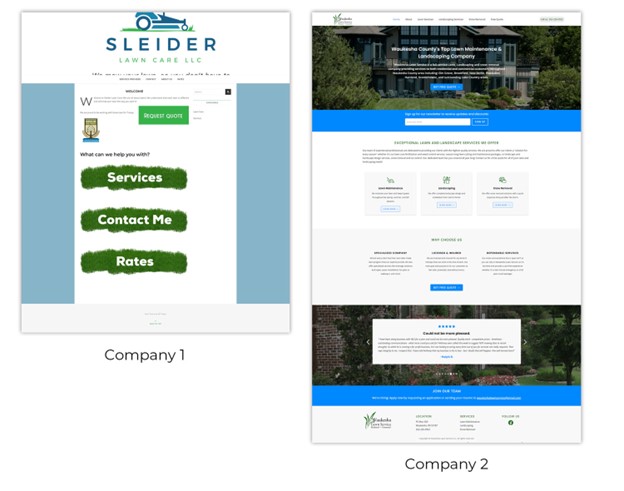Updated: March 17, 2025
Originally Published: Sept. 25, 2023
If your website has an outdated look, users might think you're no longer in business. (We’ve seen it happen!) If it’s hard to navigate, visitors will likely get frustrated and move on to a competitor. Keeping your site fresh and user-friendly is crucial for staying competitive.
Here are 10 clear signs that it might be time for a redesign.
1. Your Website Has Low Conversion Rates
If visitors aren’t taking action (buying, signing up, contacting you, etc.), your design, messaging, or CTA placements may need improvement. Your site should be built around what users need – because if it’s confusing, unengaging, or lacks value, they’ll leave and find a competitor who delivers.
Minor tweaks can help, but a complete redesign that prioritizes user needs from the ground up often yields far better results. A majority of online consumers won’t return to a site after a bad experience, and that’s a loss you can’t afford.
Think about it this way: Your website is your digital storefront. If it’s outdated, hard to navigate, or fails to deliver relevant content, visitors will ignore it. But when you put users first – ensuring seamless navigation, fresh content, and a smooth experience – they’re more likely to engage, return, and convert.
Don’t just update your site. Elevate it.
2. Your Website's Navigation Is Confusing and Inefficient
Users must quickly and easily understand how to navigate your website. Navigation directly influences the user experience.
- Well thought out navigation directs users to the information they need.
- Good organization and menu labels can alert users to additional products or services previously unknown to them.
- Beyond the navigation bar, page content should be easy to navigate. Cluttered layout or design can overwhelm users and make it hard to digest valuable information.
If your users are having a hard time finding the information they need, it’s time to update your navigation, content layouts, and possibly revamp your website’s search functionality.
3. Your Website Design is Outdated
Many users cite aesthetics as the top reason they won’t return to a website – and that tracks. A well-designed site not only creates a strong first impression but also builds trust through a thoughtful, user-friendly experience.
On the flip side, a cluttered or outdated design can undermine your credibility, making visitors hesitant to engage with your business.
For example, if you needed lawn care services, which company would you choose?

Company 1 has issues with responsive design; note the chopped-off logo and text at the top. Their services are not clearly listed on the homepage. Are the grass images clickable or not? Hard to tell. The page layout lacks structure.
Company 2 has a clear structure and clean design. The content provides the users with plenty of information, and that info funnels them further into the website. The imagery is pleasant and looks professional.
Users are likely to look at the first site and think: Are these guys still in business? Is this site secure? Should I even leave a phone number? The second company looks more professional and trustworthy.
4. Your Website Is Difficult to Update and Manage
If you avoid making changes or updates to your website because it feels too fragile or complicated, then it’s time for a redesign. Simple content changes should never be challenging or scary. You shouldn’t have to rely on developers to manage content updates.
If your website doesn’t allow for simple updates, the underlying technology could be outdated. And old design tends to go hand in hand with old tech.
Update to a more user-friendly content management system and take the time to modernize your website’s design. Make your end users and your web managers happy.
5. Your Website Isn’t Flexible Enough for Your Content
As your business evolves, so does your content. You might be launching new products, introducing services, or expanding your offerings. But if your website’s template is too rigid, you may find yourself struggling to present content effectively, forcing workarounds that compromise user experience.
Your website’s design should enhance your content, not restrict it. A flexible, well-structured site allows you to highlight key information in a way that’s clear, engaging, and easy for users to navigate. If your current layout makes it difficult to add or showcase new content, it’s a sign that your website isn’t keeping up with your business.
A redesign can provide the adaptability you need, ensuring that as your business grows, your website remains an asset, not a limitation. The right design opens up opportunities to present content dynamically, making it easier for users to engage, explore, and take action. If your website is working against you instead of for you, it’s time for a change.
6. Your Website Doesn't Match Your Brand
Your website is responsible for your company’s first impression on many prospective customers.
Does your site reflect your brand identity? If you recently rebranded, but left the website behind, it doesn’t. Even without a rebranding, your company could have evolved away from an old design.
A website that aligns with your brand:
- increases trust and credibility with your users
- becomes part of a consistent experience at every point of customer interaction
- increases brand recognition
- differentiates your business from your competitors
- makes a positive first impression.
(If you need help developing a strong brand for your business, we can provide that.)
7. You're Experiencing a Decline in Search Rankings
If your website is experiencing a drop in search engine rankings, it’s likely a sign that it isn’t fully optimized for SEO. Search engines use complex algorithms to rank websites based on factors such as content relevance, site speed, mobile-friendliness, and overall user experience. If your site is falling behind, it's important to assess both the technical structure and content.
By restructuring your site’s architecture – such as improving internal linking, updating page titles and meta descriptions, and optimizing image alt text – you’ll improve your search visibility. Additionally, refreshing your content to make it more relevant, keyword-rich, and aligned with user intent can have a significant impact on rankings, and help keep your users happy.
8. Your Website Isn’t Accessible
Your website needs to accommodate all users. Make sure that people with disabilities can comfortably use and interact with it. Note that accessibility accommodations have a way of improving overall usability, even for those without disabilities.
Accessibility includes thoughtful management and maintenance of content and thinking through design. For example: Have strong hover states on your buttons that rely on more than just a simple color change. Make sure your color scheme provides enough contrast to meet accessibility standards. WCAG 2.1 level AA requires a contrast ratio of at least 4.5:1 for normal text and 3:1 for large text.
Among considerations on the development side:
- Make sure your website can be navigated via keyboard.
- Include a skip-to-content link at the beginning of each page to allow keyboard users to bypass clicking through the navigation before getting to the content.
There’s a lot to consider when it comes to meeting accessibility requirements. To learn more about them, read our Web Accessibility: No More Excuses blog post.
9. You Don’t Really Know Your Users
Sometimes we get so caught up in our business goals that we lose sight of how users really interact with our websites. What might feel intuitive to you, as an insider, might baffle visitors. Don’t guess at this. User research is a great place to start a site redesign.
User testing helps uncover usability issues, pain points, and dead ends you might not be aware of. It highlights frustration areas, where users struggle. Websites informed by user testing tend to outperform competitors; of course they do. The humans behind these sites have done the testing, and they know what users want and need. And they give it to them.
User testing, like all UX functions, is an ongoing process, not a one-time action. Frequent user testing provides valuable feedback for improving and evolving your website over time.
To learn more, read User Testing Matters; Make Sure to Do it Well.
10. Your Competitors Have Better Websites
In today’s digital landscape, your website is often the first point of contact for potential customers. If your competitors' websites look more modern, perform faster, and offer a more engaging experience, it’s time to consider a website redesign.
A well-designed website can be the difference between winning a lead and losing it to your competition. It’s essential to assess how your website compares to others in your industry – not just in terms of design but also based on functionality, speed, content, and mobile optimization.
Investing in a redesign that incorporates current best practices will help you stay competitive, retain users, and, ultimately, grow your business. Don’t let your website hold you back while your competitors continue to pull ahead.
Remember that a website redesign should be a well-planned project that considers the specific goals and the needs of your target audience. It's also essential to consider user feedback and usability testing throughout the redesign process to ensure that any changes made match the needs of your users.
Ready to redesign your website? Reach out to us to get started!






